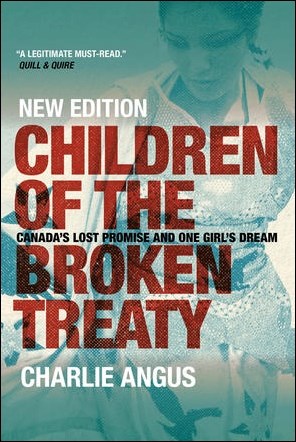Children of the Broken Treaty
By Charlie Angus
Published by University of Regina Press
$27.95 ISBN 9780889774971
Children of the Broken Treaty opens with a quote from 14-year-old Chelsea Edwards of Attawapiskat First Nation: “Perhaps you have heard of how Rosa Parks helped start the civil rights movement. Well, we are the children who have been sitting at the back of the school bus our whole lives. And we don't want to stay there anymore.”
When Rosa Parks was ordered off the bus she simply responded with: “I'm tired.” When Chelsea and her friend Shannen Koostichin “began the largest youth-driven human rights movement in the country's history” they simply said, “ I want a school.” And then they told their story to the world.
Youth across the country got it, right away. They responded, cutting through the political posturing of the Goliaths of government, demanding the children of Attawapiskat get proper schools.
Author Charlie Angus follows a movement that began in 2008 in Attawapiskat by a group of school-less students led by 14-year-old Shannen Koostachin who was encouraged by her “Grand Chief to speak the truth and from the heart.”
After finally securing a meeting with then Minister of Education and Indian Affairs, Chuck Strahl, she made the long trip from James Bay to his plush office in Ottawa prepared to tell her people's story. However, she never got a chance to tell him what he already knew, but refused to address, that her reserve was “like an internment camp, not built to last. It had no fire hall. The local medical station kept getting flooded out because of backed-up sewage. The community was on permanent boiled water advisory.”
Children were schooled in portables sitting atop “toxic dumps full of chemicals known for causing leukemia, bone marrow damage,and kidney failure.” Her neighbouring community was given the unfortunate title of the “suicide capital of the world.”
Instead the minister cavalierly pre-empted their conversation by informing her there would be no school. The elders wept. Shannen reached out to shake his hand and simply said,“We're not going to give up.”
And Shannen's Dream was born. Two years later Shannen died in a car accident. Chelsea Edwards continued as spokesperson.
Angus's meticulous reportage iterates a relentless national history of “killing the Indian in the child” begun long before residential schools, hearkening back to the Minister of the Interior Clifford Sifton, (1891-96) who once referred to the high death rate of First Nation population due to tuberculosis as “an opportunity to reduce expenditure on services like education and medical attention.”
I can't but wonder if Stahl, over 100 years later, was appealing to the kinds of constituents who still speak the language of Sifton's day, warning the minister to “keep those Indians in line.”
Despite the horrific details, Angus's book isn't asking that we steep ourselves in shame, but rather that we listen to the whole truth “with heart,” and then speak up for every child. Martin Luther King Jr. once said, “In the end we will remember not the words of our enemies, but the silence of our friends.”
We can begin by telling the story of the Children of the Broken Treaty .
— This book is available at your local bookstore or from www.skbooks.com




